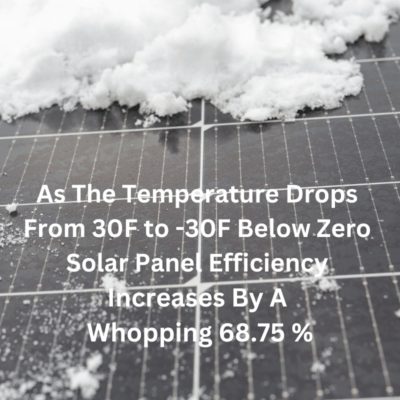
As solar technology becomes increasingly efficient and accessible, a persistent misconception remains… that solar panels do not function well in the winter. While it may seem logical to assume that cold, snowy environments are unsuitable for solar power, the truth is far more nuanced.
Solar cells rely on sunlight, not heat; many panels perform at their best under cooler temperatures. In fact, the cold can really improve the electrical efficiency of solar panels, leading to greater energy production than some might expect. When viewed through the lens of physics, engineering, and real-world deployment—including in some of the harshest environments on Earth… it is clear that solar panels can, and do, excel in winter conditions.
Understanding Solar Panel Efficiency
At the core of a solar panel’s operation are photovoltaic cells, which convert photons from sunlight into electrical current. When sunlight strikes these cells, electrons are excited and flow, generating electricity. While the intensity of available sunlight is crucial, temperature also plays a key role in panel performance.
Photovoltaic cells are sensitive to heat, and as the panel surface temperature rises, their electrical efficiency declines slightly. In other words, solar panels are somewhat like computer processors or other electronics that prefer cooler conditions. High ambient temperatures can cause a marginal drop in voltage output, reducing the usable energy they can deliver to the home or grid.
As a result, when the air is crisp and cold, the electrical conductivity of solar cells is enhanced. With less ambient heat, solar cells can produce more voltage, and the system can operate at a higher efficiency level. This phenomenon can often compensate, at least partially, for shorter daylight hours in winter months.
Even though the sun’s path is lower in the sky and cloud cover might be more frequent, the energy the panels do receive is transformed into electricity much more efficiently. In some circumstances, a sunny winter day can yield higher energy output than a very hot summer day, purely because of how temperature affects a solar panel’s performance.

As temperatures plummet, efficiency rises: Solar panels can increase their performance by close to 69% as ambient temperatures drop from 30°C down to -30°C, highlighting the surprising advantage of cold weather conditions for solar energy production.
The Benefits of Cold Weather For Solar
While winter conditions often come with challenges such as snowfall, it’s not always the hindrance one might imagine. Fresh snow can reflect sunlight, increasing the solar panel surface’s irradiance. Suppose the array is installed at an appropriate angle. In that case, snow generally slides off relatively quickly, allowing panels to continue gathering sunlight. In addition, cold air is often clearer than hot, hazy summer air, increasing the quality of the sunlight that reaches the photovoltaic cells. Combined, these factors can help offset the shorter daylight hours and ensure a steady flow of electricity, even in the dead of winter.
Examples of Solar Panels in Extreme Environments
If proof is needed that solar panels can thrive in icy, extreme conditions, one need only look to Antarctica. Research stations at the South Pole, such as those operated by various national scientific agencies, have long recognized the value of solar energy. Despite facing some of the planet’s most frigid and challenging conditions, these stations integrate solar panels into their energy mix.
The strong reflective properties of ice, combined with the exceptionally cold environment, allow these panels to operate more efficiently than expected. Though the Antarctic sun does not grace the sky year-round, solar panels can produce significant amounts of clean, reliable power during its sunlight season.
Similarly, other cold regions such as parts of Northern Canada, Scandinavia, and high-altitude mountaintops have embraced solar energy. In these places, winter snow cover can increase sunlight reflection, and the lower ambient temperatures help solar arrays maintain peak efficiency.
For remote communities, including Indigenous villages and off-grid scientific outposts, solar panels offer a dependable energy source that reduces reliance on costly and polluting diesel generators. In these extreme scenarios, solar’s capacity to function effectively in cold conditions becomes critically important, often bridging energy gaps where few alternatives exist.
Ensuring Reliability and Durability
Solar panel manufacturers and installers also take specific measures to ensure that arrays are well-suited for winter conditions. Panels are designed to withstand heavy snow loads, and their frames are often constructed from durable materials that resist warping or cracking in subzero temperatures.
Moreover, anti-reflective coatings and tempered glass are standard features that protect panels from ice, hail, and debris, ensuring that the cells below continue to receive sunlight without damage. Over time, research and development have refined these materials and mounting systems, making modern solar panels far more resilient than their early predecessors.
Adapting and Innovating for Cold Climates
As the renewable energy landscape evolves, innovations targeting winter performance continue to emerge. Some approaches include optimizing the tilt of panels for maximum winter irradiance, integrating automated snow-clearing devices, and employing bifacial panels that capture reflected light from multiple angles.
Energy storage solutions paired with these winter-ready solar systems provide added stability, ensuring that electricity generated during the daytime can be stored for use after sunset. Such technological advancements have been incredibly beneficial in regions with long, dark winters, supporting continuous renewable energy use through challenging seasons.
A Bright Future for Solar in the Cold
The notion that solar panels only work in warm climates is rapidly fading as researchers, engineers, and installers accumulate evidence of their success in the coldest places on Earth. With the ability to deliver improved efficiency in lower temperatures, solar power can, in fact, shine brightly when the mercury drops.
As extreme environments like Antarctica have demonstrated, well-designed and properly maintained solar installations operate reliably and sustainably, offering hope and inspiration to regions worldwide. In the end, the winter sun proves itself as a source of light and warmth, but of abundant, clean energy—even when the world is covered in ice and snow.


























